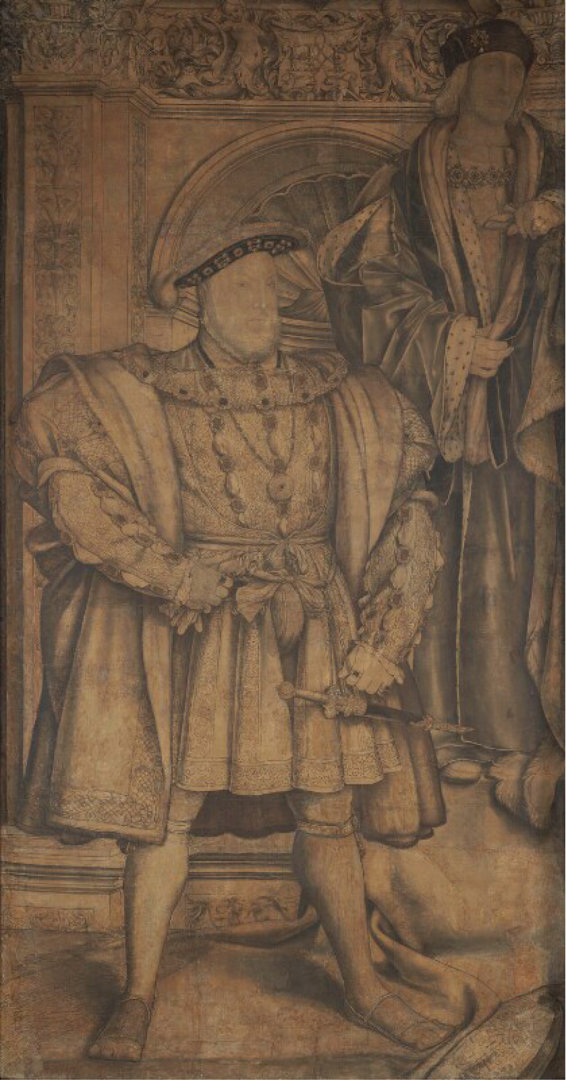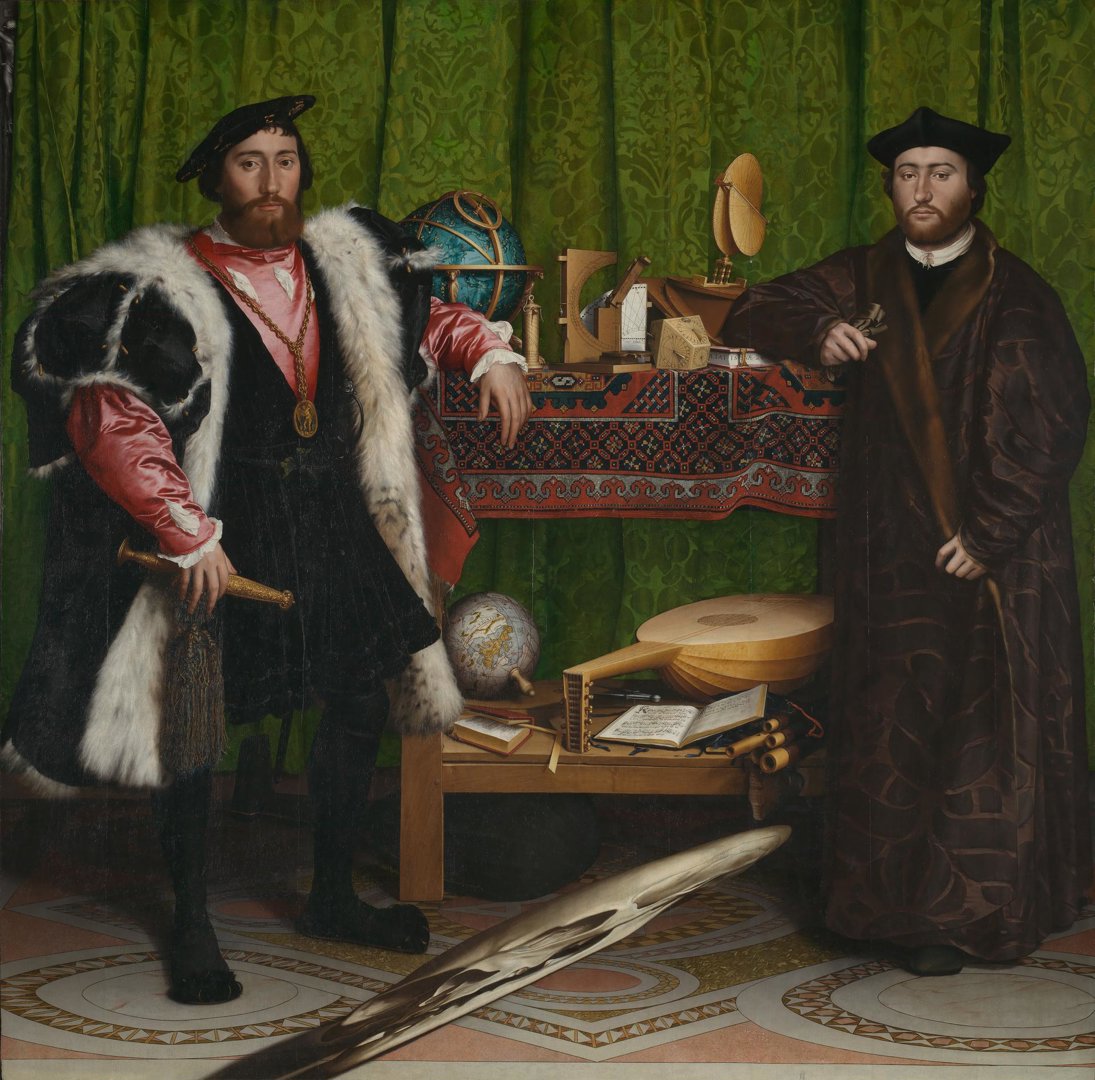Holbein’s Henry VIII and The Ambassadors go on rare public display together as more National Portrait Gallery loans announced
The National Portrait Gallery’s famous Henry VIII cartoon by Hans Holbein the Younger, is now on display for the first time in over twenty years next to the painting that partly inspired it, Holbein’s The Ambassadors, at the National Gallery.
One of the National Portrait Gallery’s most treasured works, this fragment of a preparatory drawing for a now lost painting, has very rarely been loaned since it was acquired by the gallery in 1957.
The portrait is the first in a series of works to be displayed at the National Gallery as part of the National Portrait Gallery’s major programme of activities, supported by Art Fund, which will see hundreds of works from the gallery’s collection shared across the UK when work begins on 'Inspiring People', the gallery’s biggest ever redevelopment, in July 2020.
Other portraits to be loaned to the National Gallery include Sir Antony van Dyck’s self portrait, of about 1640; 'The Sharp Family', 1799-1781 by Johan Joseph Zoffany (on long-term loan to the National Portrait Gallery); 'John Playfair', 1811, by Sir Henry Raeburn and Gwen John’s self portrait, of about 1900.
The Holbein cartoon, which shows both Henry VIII and his father Henry VII, is the only remaining fragment of a spectacular life-size preparatory drawing of a lost painted group portrait of members of the Tudor royal family.
Destroyed when the royal palace of Whitehall burnt down in 1698, the painting from 1537 (recorded in a small painted copy) featured life-size portraits of Henry VIII, his third wife Jane Seymour (who had just died after giving birth to his long-awaited male heir, the future Edward VI), and his parents Henry VII and Elizabeth of York.
The composition of this destroyed painting was inspired by Holbein’s 1533 portrait of two French ambassadors to the English court. Now the cartoon and the National Gallery’s The Ambassadors can be seen next to each other.
Instead of the shelves of objects seen in the National Gallery’s portrait of Jean de Dinteville and Georges de Selve, in the Whitehall finished painting Holbein included a tablet praising the achievements of the new Tudor dynasty.
As well as 'The Ambassadors', the cartoon can now be seen alongside two other Holbein paintings from the National Gallery’s Collection - Christina of Denmark, Duchess of Milan (1497/8–1543), which is another life–size portrait, and A Lady with a Squirrel and a Starling (Anne Lovell?) (about 1526–8); and a portrait, on long term loan, of the great Dutch philosopher Erasmus. This free display in Room 2 offers an exceptional opportunity to see five outstanding works by Holbein together.
Dr Nicholas Cullinan, Director of the National Portrait Gallery, London, says: ‘We are delighted our renowned Holbein cartoon has gone on display at the National Gallery, where it can be seen in an enlightening new context alongside 'The Ambassadors', which partly inspired it. These two potent images of power and politics are striking examples of the Tudor dynasty and diplomacy. Seen in the flesh and side by side, the parallels are fascinating, while the juxtaposition of preparatory drawing and finished oil painting reveals Holbein’s meticulous process.’
Dr Gabriele Finaldi, Director of the National Gallery, London, says: ‘This exceptional juxtaposition of 'The Ambassadors' and the National Portrait Gallery's cartoon of King Henry VIII with his father, Henry VII, provides a unique opportunity to see how Holbein fashioned portraits of power at the Tudor court. Never in England had propaganda images been elaborated with such compelling force and such sublime artistry. They remain to our modern eyes extraordinarily impressive.’
NOTES TO EDITORS
Image credits
Top: Hans Holbein the Younger (1497 or 1498-1543) King Henry VIII; King Henry VII, about 1536-7 © National Portrait London, London
Lower: Hans Holbein the Younger, (1497 or 1498 – 1543) Jean de Dinteville and Georges de Selve ('The Ambassadors'), 1533 © The National Gallery, London
The works
NPG 4027: King Henry VIII; King Henry VII by Hans Holbein the Younger, ink and watercolour, about 1536-7, 101 1/2 in. x 54 in. (2578 mm x 1372 mm), Accepted in lieu of tax by H.M. Government and allocated to the National Portrait Gallery, 1957
To commemorate the strength and triumphs of the Tudor dynasty, Henry VIII commissioned from Holbein a wall-painting for Whitehall Palace; this was completed in 1537. The immediate impetus for the commission may have been the birth or the expectation of the birth of Henry's son Edward, later Edward VI, in October 1537. The mural may have been in Henry's Privy Chamber and therefore have had a select, restricted audience rather than being an image of wider propaganda. This very large drawing is the preparatory drawing or cartoon for the left-hand section of that wall-painting, and shows Henry with his father Henry VII, the founder of the dynasty. The right-hand section showed Henry VIII's third wife Jane Seymour (1509?-37) and his mother Elizabeth of York (1465-1503). Holbein's painting was destroyed in the Whitehall Palace fire of 1698, and the cartoon for the right-hand side section is lost. The appearance of the whole painting is however recorded in a mid-seventeenth century copy by Remegius van Leemput in the Royal Collection. The cartoon is executed in black ink and watercolour on several sheets of paper joined together. The figures and faces of the kings are cut-outs pasted on to the backing paper. The cartoon is exactly the same size as the finished painting and was used to transfer Holbein's design to its intended position on the palace wall. To do this the cartoon was pricked along the main outlines of the composition and then fixed in the intended position on the wall. Chalk or charcoal dust was then brushed into the holes made by pricking, thus transferring the outline to the wall. Holbein could then proceed with filling in his design.
NG1314: Jean de Dinteville and Georges de Selve ('The Ambassadors') by Hans Holbein the Younger, 1533, oil on oak, 207 x 209.5 cm; Bought by the National Gallery, 1890
Jean de Dinteville, the man on the left, is shown on his second diplomatic mission to England on behalf of Francis I, King of France. To the right is his close friend, Georges de Selve, Bishop of Lavaur. This portrait was painted at a time of religious upheaval in Europe. Although the pope had refused to annull Henry VIII, King of England’s marriage to Catherine of Aragon which resulted in a break with the Roman Catholic Church, in 1533 he married Anne Boleyn. The array of objects on the table seem to allude to discord; the arithmetic book, for example, is open at the page concerning mathematical division.
The portrait is a supreme display of Holbein’s skill in composing images and in manipulating oil paint to recreate a variety of textures. If viewed from a particular angle the elongated shape between the men’s feet becomes a skull. Equally hidden at the top left of the picture is a crucifix that hints at the hope of redemption in the resurrected Christ.
Holbein’s King Henry VIII; King Henry VII at the National Gallery
Open to public: From Thursday 5 March 2020 onwards
The National Gallery, Room 2, Admission free
National Gallery opening hours
Daily 10am–6pm (last admission 5pm) / Fridays 10am–9pm (last admission 8.15pm)
For more information please visit: nationalgallery.org.uk
National Portrait Gallery
Founded in 1856, the aim of the National Portrait Gallery, London is ‘to promote through the medium of portraits the appreciation and understanding of the men and women who have made and are making British history and culture, and ... to promote the appreciation and understanding of portraiture in all media’. The Gallery holds the most extensive collection of portraits in the world. www.npg.org.uk
The National Portrait Gallery, will share its unique Collection of portraits with the nation in a major programme of activities across the UK, supported by The National Lottery Heritage Fund (NLHF) and a grant from Art Fund, as work begins on Inspiring People, the Gallery’s biggest ever redevelopment, in July 2020.
Inspiring People will transform the National Portrait Gallery. Designed by Jamie Fobert Architects and supported by The National Lottery Heritage Fund, the project comprises a comprehensive re-display of the Collection from the Tudors to now, combined with a complete refurbishment of the building, the creation of new public spaces, a more welcoming visitor entrance and public forecourt, and a new state of the art Learning Centre. In order to complete the project efficiently and to safeguard visitors, members of staff and the Collection, the Gallery in St Martin’s Place will temporarily close to the public from 29 June 2020 until spring 2023, while essential building works take place.
The National Gallery
The National Gallery is one of the greatest art galleries in the world. Founded by Parliament in 1824, the Gallery houses the nation’s collection of paintings in the Western European tradition from the late 13th to the early 20th century. The collection includes works by Bellini, Cézanne, Degas, Leonardo, Monet, Raphael, Rembrandt, Renoir, Rubens, Titian, Turner, Van Dyck, Van Gogh and Velázquez. The Gallery’s key objectives are to enhance the collection, care for the collection and provide the best possible access to visitors. Admission free. More at nationalgallery.org.uk
Art Fund
Art Fund is the national fundraising charity for art. It provides millions of pounds every year to help museums to acquire and share works of art across the UK, further the professional development of their curators, and inspire more people to visit and enjoy their public programmes. Art Fund is independently funded, supported by the 159,000 members who buy the National Art Pass, who enjoy free entry to over 240 museums, galleries and historic places, 50% off major exhibitions, and receive Art Quarterly magazine. Art Fund also supports museums through its annual prize, Art Fund Museum of the Year, which was won by St Fagans National Museum of History, Cardiff, in 2019, and through a range of digital platforms. www.artfund.org
National Gallery Press Office on 020 7747 2865 or email press@ng-london.org.uk
Publicity images can be obtained from https://press.nationalgallery.org.uk/
National Portrait Gallery Press Office on 020 7321 6435/6620 or email press@npg.org.uk
Publicity images can be obtained by emailing press@npg.org.uk


